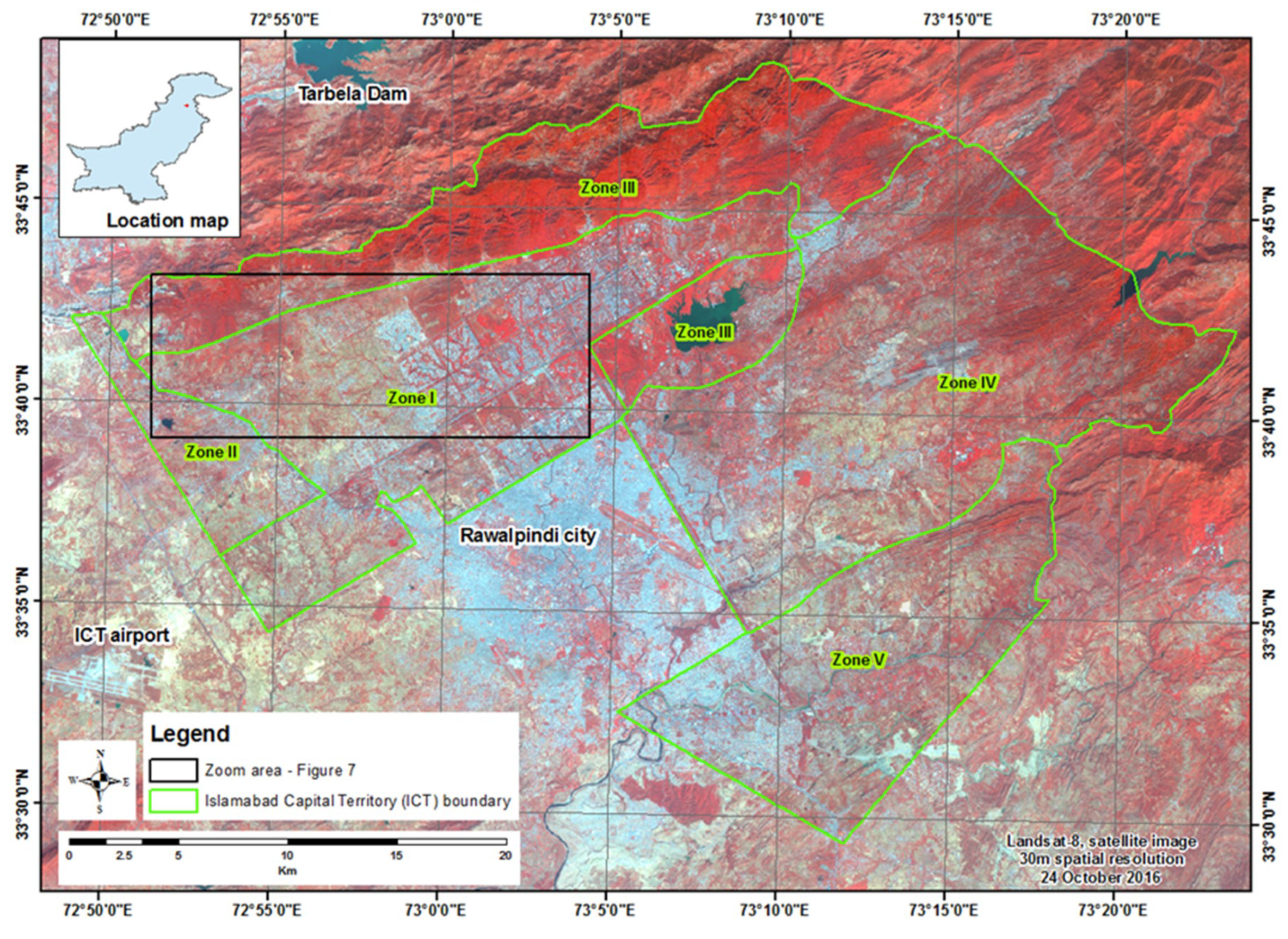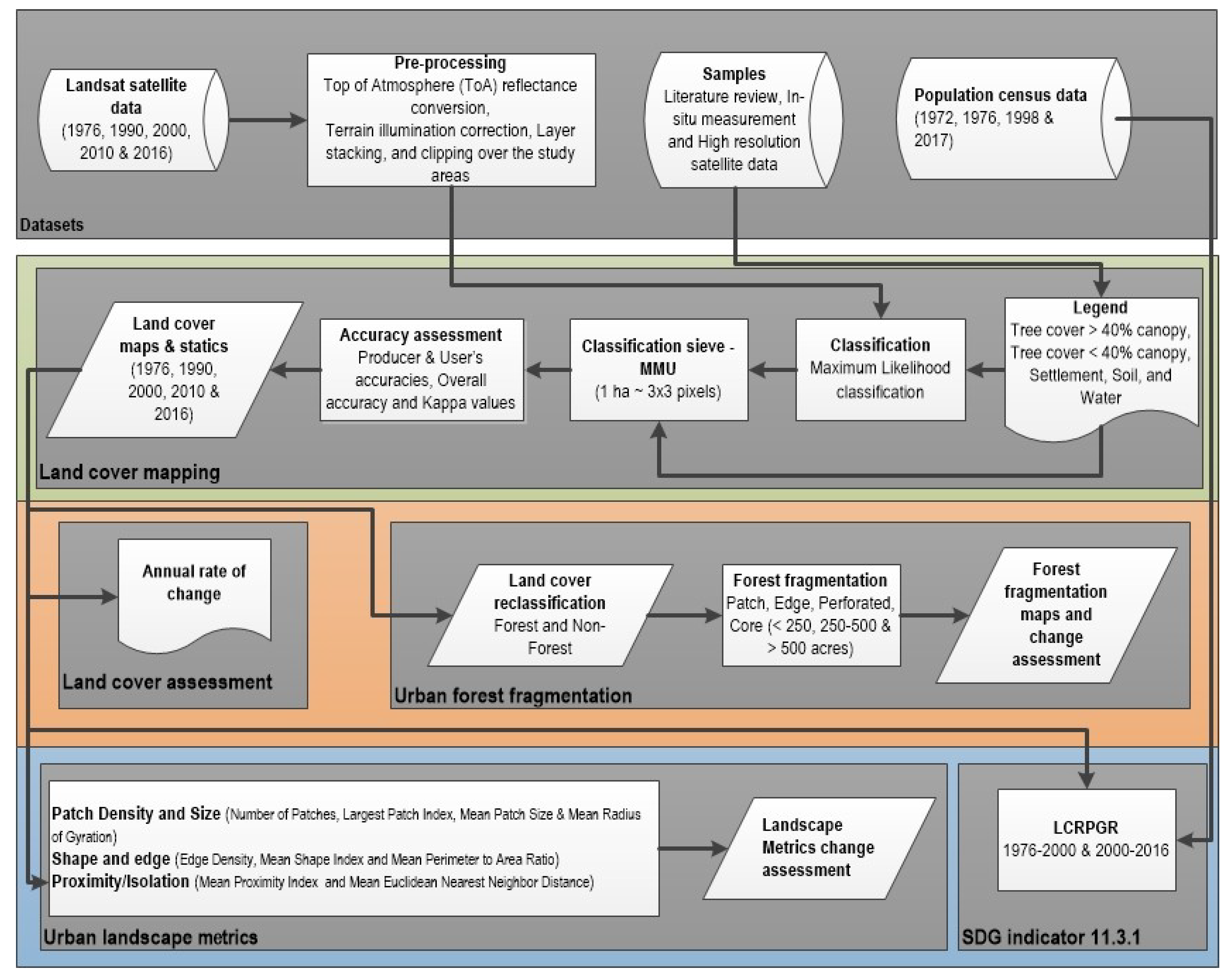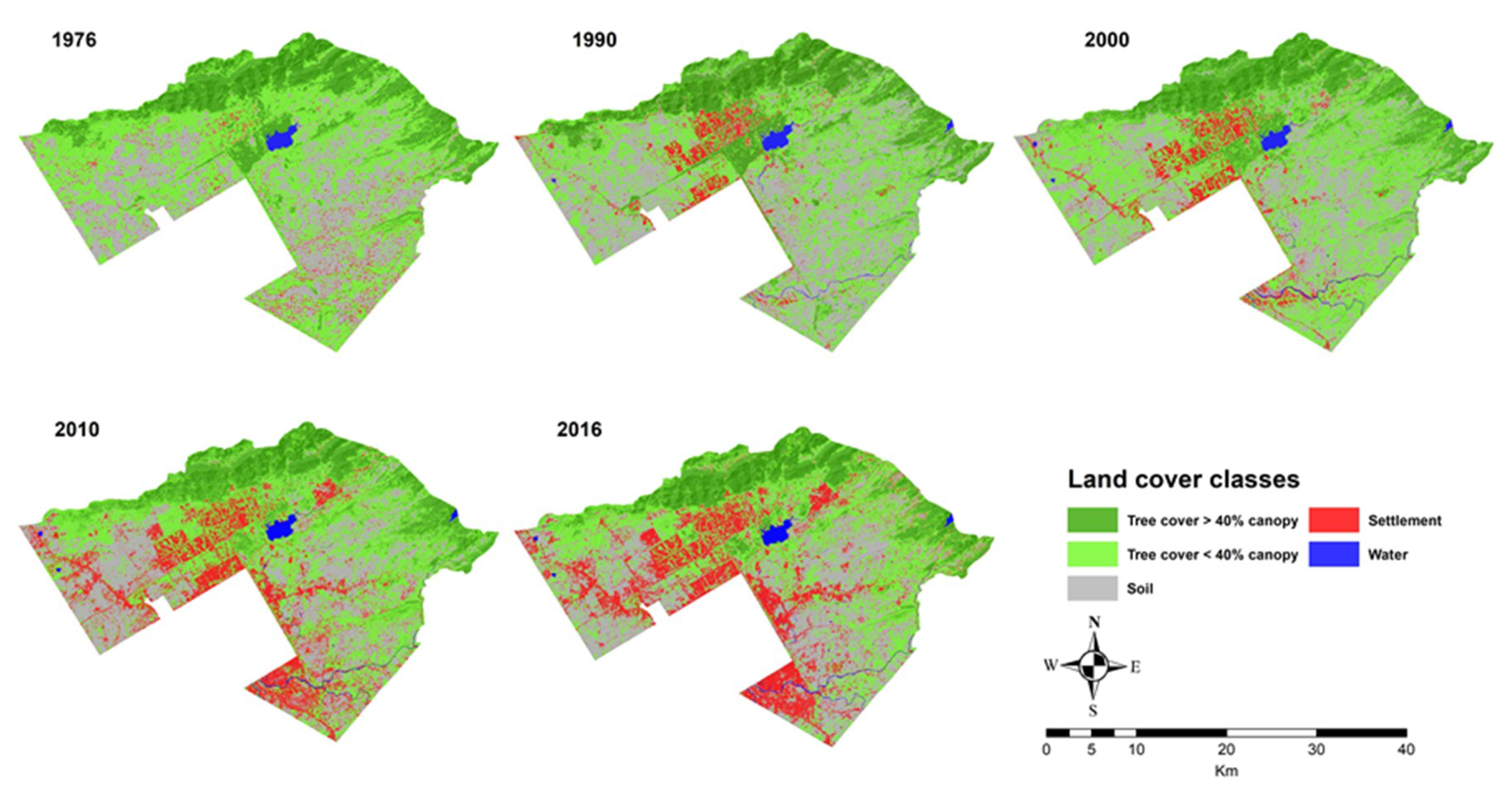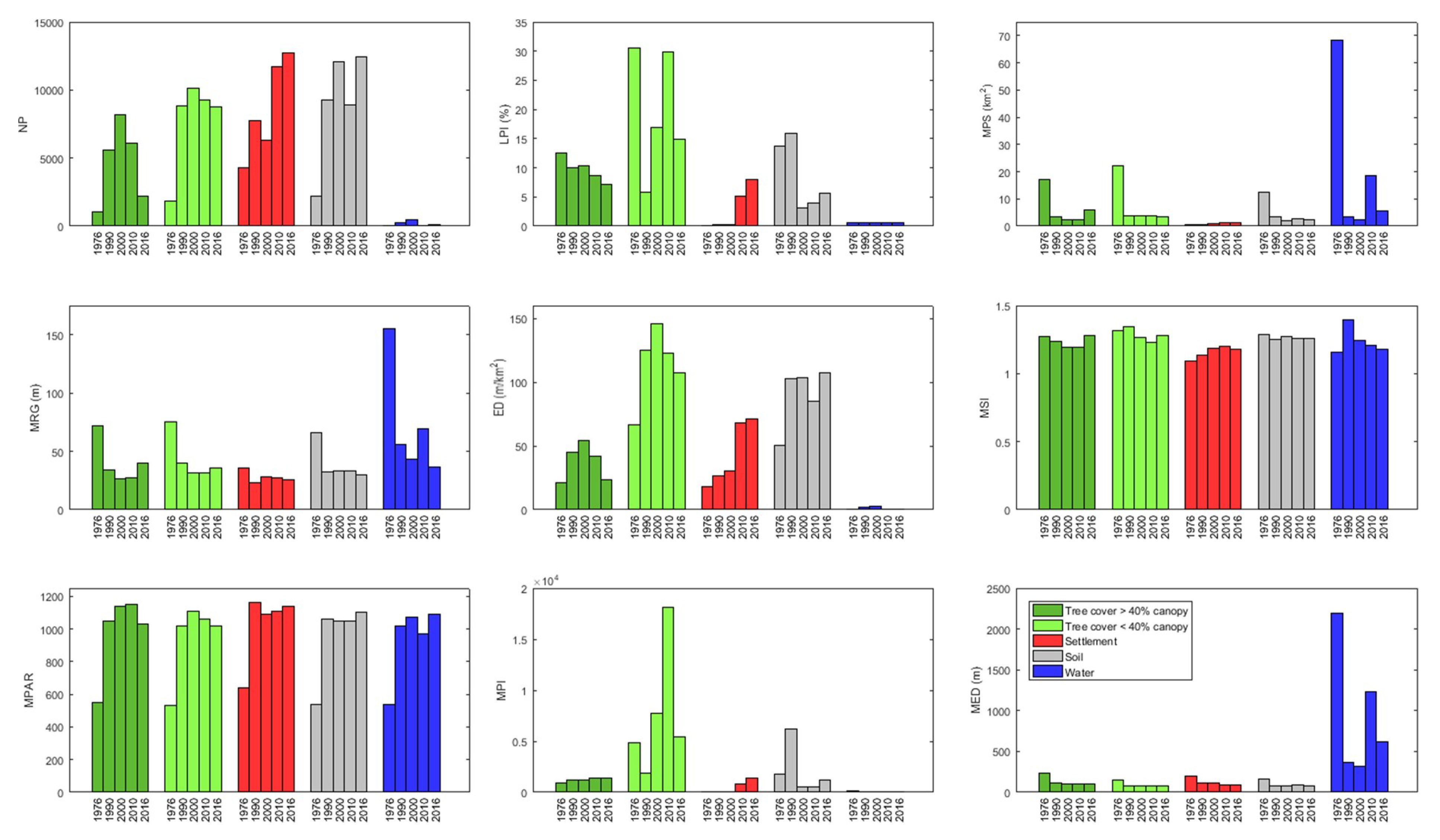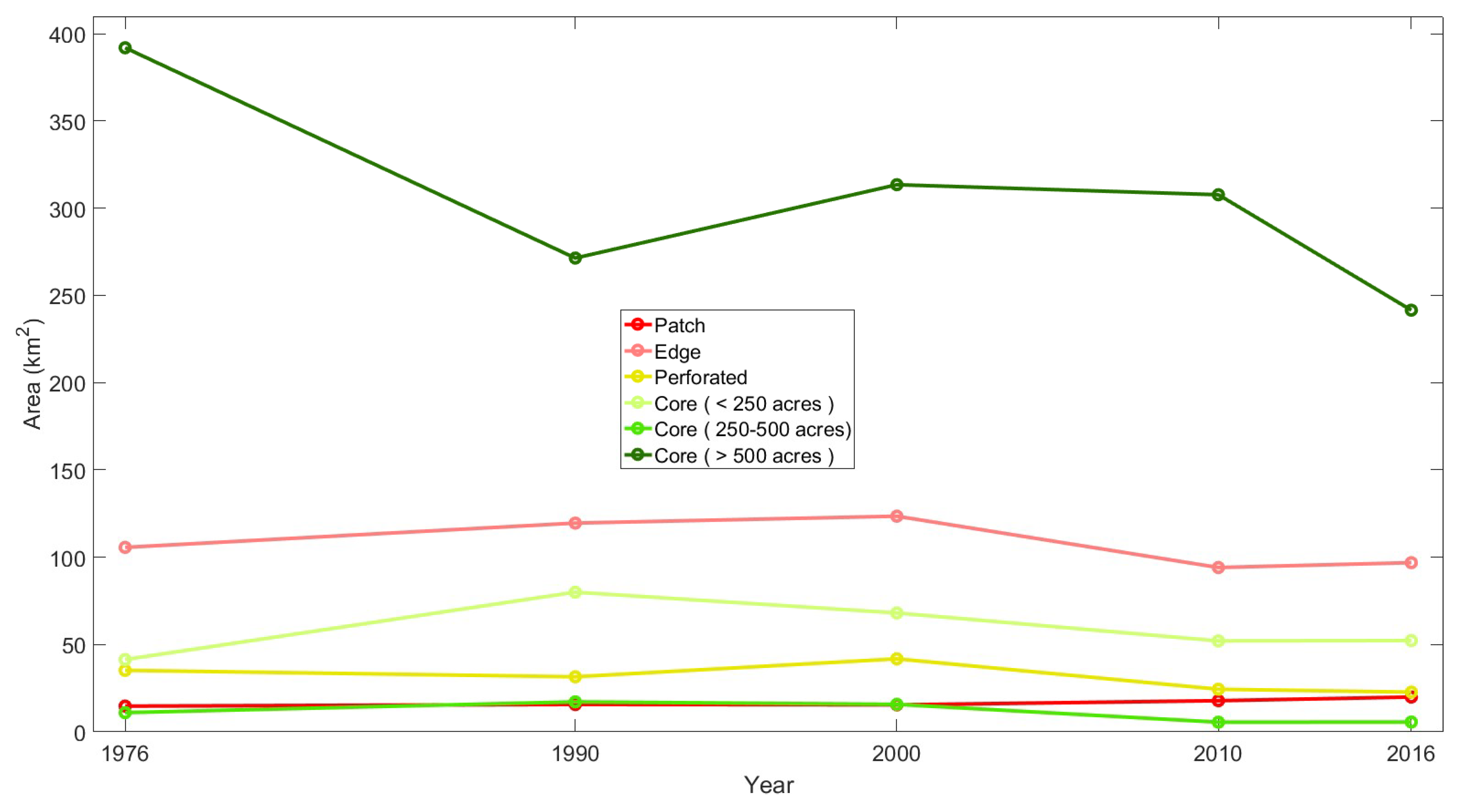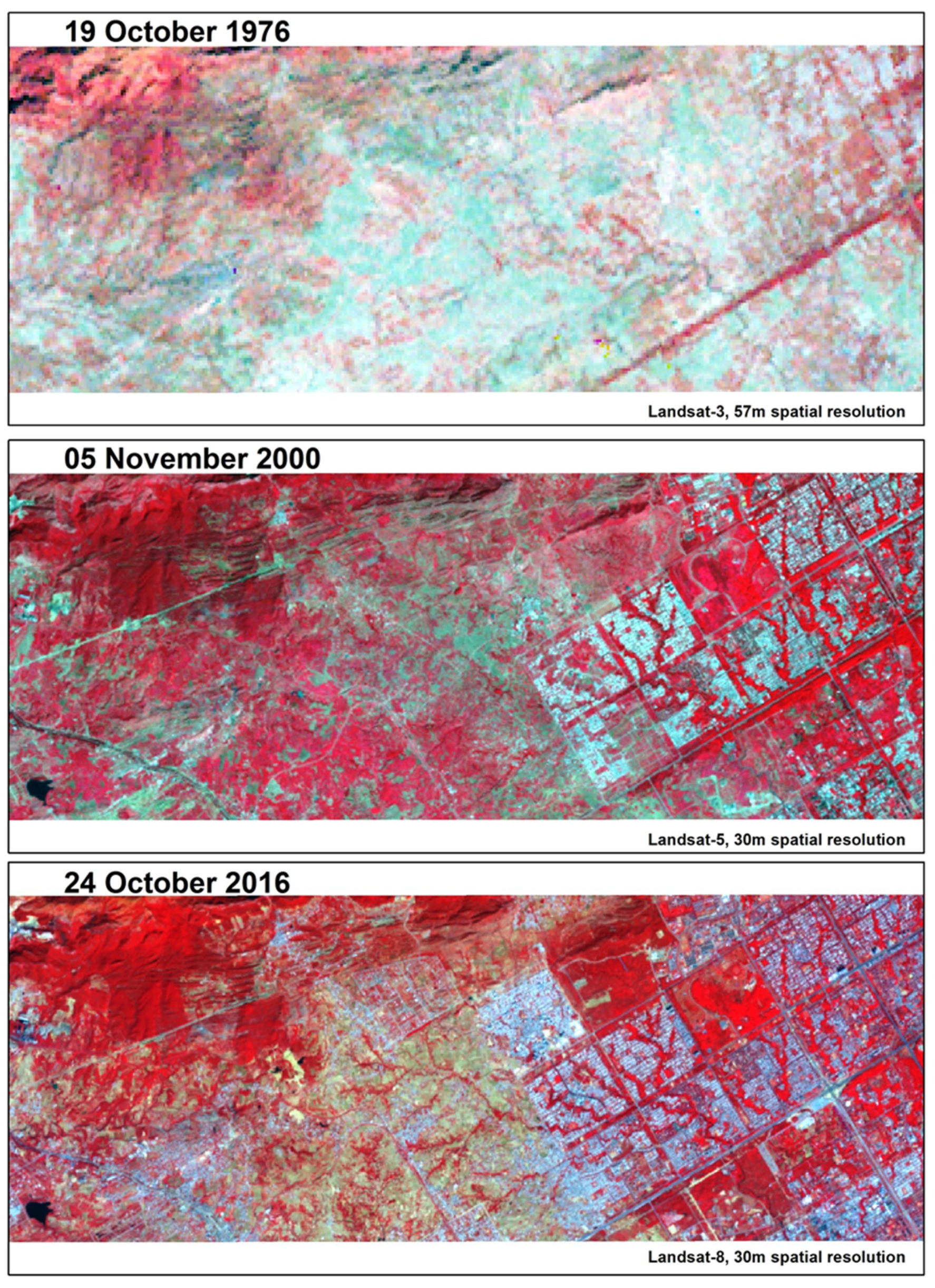1. Introduction
The conversion of one land cover type to another is one of the most visible and rapid changes that the earth is experiencing and these conversions have profound social and environmental impacts at multiple scales. In the past, the drivers of land cover changes have been classified into two categories: proximate and distant, or indirect [
1]. Recently, the phenomenon of tele-coupling between places has been recognized as key to understanding how distant drivers relate to proximate drivers and influence local landscape changes [
2,
3,
4]. Some of the key drivers of landscape changes include economic, technological, institutional and policy, cultural, and demographic factors [
5].
The growth of urban areas leads to land cover change in many parts of the world, especially in developing countries [
3,
6]. Intense urbanization and increase in anthropogenic activities reflect the scope, intensity, and frequency of human interference, and the changes they cause in ecological processes and systems in the urbanized areas [
7]. The urban areas consist of only 1–6% of the earth’s land surface, yet they have enormous impacts on the functioning and service of local and global ecosystems, by modifying local climate conditions, eliminating and fragmenting native habitats, generating anthropogenic pollutants, etc. [
8]. The spatial pattern of an urban landscape is a result of the interaction between various driving forces including natural and socioeconomic factors [
9]. Increasing trends in industrialization and urbanization, along with the migration from rural to urban areas, are the most dominant factors influencing the land cover transformation. In the rural areas, employment opportunities and income are insufficient, which contributes to large differences in income and facility levels between urban and rural areas [
10]. In developing countries, new cities are being developed due to human migration, infrastructure development, and growing job opportunities [
10,
11].
The United Nations (UN) Sustainable Development Goals (SDGs) are a collection of 17 global goals, which include 232 indicators set by the UN General Assembly for the year 2030. These goals are an urgent call for action by all countries—developed and developing—in a global partnership. Pakistan is a signatory to the UN SDGs, and this study analyzes the land use change dynamics of Islamabad Capital Territory (ICT) in the context of the relevant SDGs and indicators. The Goal 11 of the SDGs, “Make cities and human settlements inclusive, safe, resilient and sustainable”, with indicator number 11.3.1 “Ratio of Land Consumption Rate to Population Growth Rate (LCRPGR)” [
12] is an important parameter for analyzing sustainability of land use and land change with population growth. The LCRPGR parameter is actually based on the previously defined parameters of LCR [
13,
14] and PGR [
15], and several studies of urban areas have been carried out before on the basis of these parameters. The LCRPGR parameter and terminology has been given prime importance now after being linked with the UN defined SDGs. LCRPGR is vital to understand the rate of land change as compared to the population boom, to understand historical land consumption traditions, and to guide decision and policy makers on the planned expansion of the city along with the protection of environmental, social, and economic assets. Another SDG, Goal 15, “Protect, restore and promote sustainable use of terrestrial ecosystems, sustainably manage forests, combat desertification, and halt and reverse land degradation and halt biodiversity loss” emphasizes the protection of tree cover and sustainable management of forests. The SDG indicator number 15.2.1, "Progress towards sustainable forest management" [
16] calls for sustainable management strategies for conserving the forest cover, enhancing environmental education, and engaging a wide range of stakeholder institutions, policies, regulations, and considerations that promote sustainability and utilization of natural resources at multiple spatial scales [
17].
Assessment and monitoring of land cover dynamics is essential for the sustainable management of natural resources, environmental protection, biodiversity conservation, and developing sustainable livelihoods. Therefore, the development of applicable and systematic methods for producing and updating land cover databases are considered an urgent need [
18]. Around the globe, urban land expansion rates are higher than or equal to urban population growth rates [
19,
20,
21]. Many research studies focus on big cities and metropolises, where increase in population through analysis of census statistics is directly linked with the urban land expansion; however, these statistics do not provide information regarding spatial distribution, pattern, and scale of urban land use change. Multi-temporal land cover change analysis and simulation based on coarse to very high resolution satellite remote sensing images is becoming a well established technique for quantifying changes occurring on the earth’s surface, and multi-temporal aerial and satellite datasets are now widely and continuously being used for urban growth mapping, monitoring, and modeling with a focus on the spatial dimension and structures [
22,
23,
24,
25]. In urban expansion studies, spatiotemporal analysis of land cover and land use changes has helped towards understanding the underlying natural and socio-economic factors and drivers. For instance, Seto et al. [
26] have presented a meta-analysis of 326 studies which used temporal satellite images to map urban land conversion. A total of 58,000 km
2 increase in urban land area was reported in thirty years (1970 to 2000) and by 2030, global urban land cover is expected to increase between 430,000 km
2 and 12,568,000 km
2, with an estimate of 1,527,000 km
2 more likely. According to Seto et al. [
26], across all regions and for all three decades, urban land expansion rates are higher than or equal to urban population growth rates. Yang et al. [
27] studied and reported the evidence of urban agglomerations through satellite images in four major bay areas of US (San Francisco and New York), China (Hong Kong-Macau), and Japan (Tokyo), from 1987 to 2017.
Clarke et al. [
28] proposed a framework to combine remote sensing and spatial metrics for improved understanding and representation of urban dynamics to come up with alternative conceptions of urban spatial structure and change. Particularly with regards to urban forestry, a few studies have focused towards the assessment, mapping, and monitoring of urban forest parameters in fast-growing cities of developing countries. For example, Gong et al. [
29] carried out a 30-year forest fragmentation study over Shenzhen Special Economic Zone (SEZ), a city which was established in 1979 in Southern China. Huang et al. [
30] utilized satellite images of 77 metropolitan areas in Asia, US, Europe, Latin America, and Australia to calculate and analyze seven spatial metrics (area weighted mean shape, area weighted mean patch fractal dimension index, centrality, compactness index, compactness index of the largest patch, ratio of open space, and density). According to their analysis, the compactness, density, and regularity of urban areas in developing regions generally exceeded the levels reported throughout developed countries [
30]. Dewan et al. [
31] studied the dynamics of land use/cover changes though landscape fragmentation analysis in Dhaka Metropolitan, Bangladesh, computing and analyzing the following metrics: Number of patches, Patch density, Landscape shape index, Largest patch index, Mean patch size, Area-weighted mean fractal dimension, Interspersion and juxtaposition, Contagion, and Shannon’s diversity index.
In Pakistan, like other developing countries, most urban development is haphazard, typically lacking appropriate planning strategies [
10]. Pakistan’s urbanization rate is the highest in South Asia, and by 2030, Pakistan will have more people in cities than in rural areas. Growing population and rapid development is causing prime agricultural land to be encroached and also causing loss of tree cover [
32,
33,
34,
35,
36]. In the late 1960s, the capital of the Islamic Republic of Pakistan was shifted from Karachi to Islamabad (officially named Islamabad Capital Territory (ICT)). The masterplan of ICT was developed by the famous Greek architect and town planner C. A. Doxiadis [
37]. In terms of a planned new capital, ICT is similar to planned new post-colonial capitals/relocations as in the cases of Brasilia (Brazil), Nur-Sultan (named as Astana from 1998 to 2019, and Akmola previously) in Kazakhstan, and Canberra (Australia) [
38,
39,
40]. In the recent decades, with various ongoing development activities, ICT has been struggling with rapid urbanization and gigantic levels of pollution from industrial, residential, and transportation sources. In terms of population, ICT is considered as the most diverse city of Pakistan with a large percentage of immigrants and foreigner population [
41]. Unprecedented influx of migrants and population increase has resulted in urban sprawl and conversion of fertile agricultural land and green cover into concrete—a clear deviation from the original ICT master plan [
39,
40]. Uncontrolled population growth in ICT due to rapid urbanization has deteriorated the living environment, and increased the adverse ecological impacts on human health, flora, and fauna [
42].
1.1. Literature Review—ICT Mapping and Monitoring
In the last 20 years, several studies have been conducted on the ICT, regarding land cover change, biomass estimation, water quality monitoring, and temperature increase using satellite datasets. In this section, we present a synthesis of published work regarding land cover change dynamics in the ICT.
Adeel [
43] identified urban growth potential through land use for ICT zone IV (
Figure 1), based on SPOT-5 2.5 m panchromatic dataset and population census data, and found that nearly 63% of zone IV carries a ’High’ to ’Very High’ future growth potential, which is mainly located close to Islamabad Expressway. This work uses satellite imagery and field data from one year (2007) and does not report spatiotemporal change dynamics. Butt et al. [
35] studied the metropolitan development in ICT, based on growth direction and expansion trends from the city center, for the period 1972–2009 using Landsat satellite images. Using Principal Components Analysis (PCA), band ratios, and supervised classification methods, they found that the urban development had expanded by 87.31 km
2 in 38 years. Butt et al. [
44] conducted a study on land cover change analysis over Simly dam watershed, ICT; the results derived from maximum likelihood supervised classification showed tree cover loss of up to 26% and 6% increase in settlements from 1992–2012, based on Landsat 5 TM and SPOT-5 imagery, respectively. Similarly, the watershed analysis of Rawal dam, ICT using Landsat 5 TM imagery, showed 3% degradation of tree cover and 2% gain of settlement from 1992–2012 [
45]. Another ICT land cover change dynamics study conducted by Hassan et al. [
46] utilized 30 m Landsat 5 TM data for 1992 and 2.5 m SPOT-5 data for 2012, using the maximum likelihood algorithm for image classification. The study revealed a decrease in forest cover of approximately 49% and over 213% gain of settlement area from 1992–2012. Sohail et al. [
47] conducted a study to assess the water quality index and analyze the major change in land cover types, vegetation cover, rate of urbanization and its possible impact on groundwater resources, vegetation, and barren land. They used Landsat images for the years 1993, 1997, 2002, 2007, 2013, and 2017 for the assessment and mapping of land cover dynamics; according to their findings, from 1993 to 2017, vegetation areas decreased by 101.77 km
2, surface water was reduced by 1.10 km
2, barren land was reduced by 2.90 km
2, while built-up lands expanded by 105.77 km
2.
A comparison of Beijing, China and ICT for the role of vegetation in “controlling the eco environmental conditions for sustainable urban environment” was performed by Naeem et al. [
42], where they used Gaofen-1 (GF-1) and Landsat-8 Operational Land Imager (OLI) satellite imagery with 8 m and 30 m spatial resolution, respectively. They evaluated various scenarios and models for future development to predict future spatial patterns in both cities. Another study was conducted by Naeem et al. [
48] to study the association between green space characteristics, analyzed through landscape metrics, and land surface temperature for sustainable urban environments comparing Beijing, China and ICT.
Khalid et al. [
49] conducted a study to quantify the decline of forest reserves and associated temperature variations in a relatively unexplored biodiversity hotspot of ICT, the Margalla Hills National Park (MHNP). In this work, Landsat satellite imagery from 1992, 2000, and 2011 was used to monitor the changes in forest cover and statistical significance tests were used to determine the significance of temperature variation associated with a shift in land cover classes. The study finds that deforestation and forest degradation by local communities is an ongoing practice in MHNP; this necessitates the promotion of conservation practices to minimize ecological disturbances here [
49]. Batool and Javaid [
50] carried out a study on the assessment of Margalla Hills forest by using Landsat imagery for years 2000 and 2018, and report that the forest cover has decreased from 87% in 2000 to 74% in 2018, whereas built-up area has increased from 5% in 2000 to 7% in 2018, and open land in the study area increased from 2% in 2000 to 7% in 2018. Mannan et al. [
51] conducted a study using Landsat imagery, Markov Chain, and Cellular Automata on Margalla Hills, focusing on the quantitative assessment of spatiotemporal land use and land cover changes during 1998, 2008, 2018, and a simulation of 2028. In addition, a forest inventory survey was conducted for biomass and carbon sink estimations. This work shows that the forest area has reduced from 409.36 km
2 to 392.31 km
2 and settlement area has increased from 14.97 km
2 to 39.66 km
2 from 1998 to 2018. The average yearly biomass and carbon losses were 50.34 Gg/ha/yr and 31.33 Gg C/ha/yr, respectively.
The ICT is a relatively new and spatially heterogeneous city surrounded by the Himalaya mountainous dense forest as compared to other fast growing and expanding cities like Dhaka, Bangladesh [
31,
52,
53,
54,
55], New Delhi, India [
56], Beijing, China [
42,
48,
57,
58], Shanghai, China [
59,
60,
61], Tokyo, Japan [
27,
62], etc. Based on the literature review, we observed that most studies of the ICT land cover dynamics have used different remotely sensed data, methods, definitions, and classification schemes, and have provided diverse results. Most studies which have analyzed the land change dynamics in the ICT focus on the overall analysis of land-cover and land-use change, and a detailed analysis of the landscape ecology and urban forestry characteristics is missing. There has further been very little focus in these studies towards urban landscape metrics and indicators of sustainable urban growth such as LCRPGR.
1.2. Study Objectives
In this paper, well established, proven, and articulated research methodology, satellite datasets, and definitions of features were adopted with the goal to systematically achieve the following defined objectives:
Detection, measurement, and characterization of land cover features using Landsat medium resolution freely available satellite data (1976, 1990, 2000, 2010, and 2016) and determine the annual rate of change in land cover classes at 10 years interval.
Landscape metrics and forest fragmentation spatiotemporal analysis, to estimate and report changes in the ICT urban ecosystem over forty years.
Calculation of SDG indicator number 11.3.1 “Land Consumption Rate to the Population Growth Rate (LCRPGR).”
5. Discussion
The present study was conducted in order to quantitatively analyze the landscape change dynamics in the ICT from 1976 to 2016 using medium spatial resolution Landsat images. In this study, we observed an increase in settlements over the last forty years. The dramatic land cover change in settlements is exerting severe pressure on other land cover classes, particularly tree cover and soil. Already existing urban areas can be seen expanding through rapid construction of residential blocks in the form of housing societies, industrial blocks and road expansions, leading to horizontal and vertical developments in the city and development of lavish farm houses in the vicinity areas (
Figure 7). This rapid increase in urbanization is linked also with migrations. Urban growth may have positive or negative impacts on the environment but unplanned growth of urban areas has negative effects. For the economic development of the country, necessary planning is required to make urbanization helpful, as social, health, and environmental issues often accompany the process of urbanization.
In the time span of forty years, an overall decrease has been observed in the area of tree cover classes (i.e., greater than and less than 40% tree canopy) in the ICT, and most of the tree loss has occurred after the year 2000 with a corresponding increase in built-up areas. Apart from tree cutting, another important reason behind rapid tree loss or degradation is forest fires. In the Margalla Hills, forest fires usually take place during dry hot climate conditions when there is no rain for months and temperature goes up to 45 °C. According to Khalid and Ahmad [
78], a total of 320 forest fires were recorded from 2002 to 2012 and approximately 8 km
2 area got burnt as a result. In the ICT, due to uncontrolled urbanization and lack of awareness, huge tree loss has been observed in the last sixteen years, i.e., 2000–2016. Another factor for forest degradation is uncontrolled grazing of livestock [
78]. As such, there are no adequate plans or manageable methods to stop grazing activities. For ecotourism and public awareness drives, a number of jogging and hiking trails have been formed in Margalla Hills National Park, and a large number of visitors has severely affected the Margalla Hills National Park by dumping waste. These illegal and unmonitored activities in the forested area cause threats to the forest ecosystem [
50,
79].
Massive migrations have occurred over the past few years from rural to urban areas, mostly due to low cultivated land output, landlessness, sub-division of land, poor economy, and better educational and health opportunities in urban areas. The rapid increase in population has contributed towards natural resource depletion and rapid deforestation close to settlements [
80].
The LCRPGR parameter is an indicator of urban sustainable development, whether urban expansion is in balance with population growth or not. According to literature review, limited scientific peer reviewed studies have been reported on the monitoring and mapping of LCRPGR. Under each SDG, a number of targets and indicators have been defined, which countries have to quantify, but most of the developing countries do not have comprehensive databases through which they can compute, quantify, and report the SDGs indicators. To the best of the authors’ knowledge, only Nicolau et al. [
77] and Wang et al. [
81] have computed and reported scientific results of SDG proposed LCRPGR over urban areas. Nicolau et al. [
77] based their study over the mainland of Portugal, while Wang et al. [
81] carried out their study over mainland China, using earth observation and population census data, and reported the increase of LCRPGR value from 1.69 in 1990–2000 to 1.78 in 2000–2010. The LCRPGR related research findings from these studies show that in most cities, both horizontal and vertical urban expansions are carried out in an unplanned manner which has already effected the equilibrium of land consumption versus population increase to attain effective development goals by 2030 [
77,
81]. In this study over the ICT, the LCRPGR ratio was 0.62 from 1976 to 2000, which increased to 1.36 from 2000 to 2016. Based on studies conducted on the global scale, in the most of the cases LCR is higher than or equal to PGR due to high demand of luxurious occupancies in the urban areas [
26,
30].
The Shenzhen SEZ and ICT cities were both developed in late 1970s. In terms of urban forest cover change, Shenzhen SEZ had been restored to ~85% (1973–2005) [
29] while in this study, we detected urban forest loss of ~27% (1976–2016) in the ICT. In both cities (SEZ and ICT), urban forest fragmentation results revealed losses in forest patches. In South Asia, the landscape of the ICT resembles strongly with the cities of Kathmandu (the capital of Nepal) and Thimphu (the capital of Bhutan), as they are all cities topographically surrounded by the pine trees. As compared to ICT, Kathmandu and Thimphu cities are older but highly migrant resident populated, vastly encroached, and over grazed. Although many studies have investigated the land cover dynamics of Kathmandu and Thimphu cities using temporal satellite data [
82,
83,
84,
85], detailed analysis using parameters such as landscape metrics, forest fragmentation, and LCRPGR has not been performed. In this aspect, this study serves as a methodological framework for application and analysis over other similar cities in developing countries.
Due to rapid tree loss and urbanization, the ICT has observed rapid spells of dust storms and soil erosion [
86]. Soil erosion, dry temperatures, and consequent dust storms have a negative impact in the form of air pollution [
87] and land degradation. The soil in ICT and the surrounding areas is shallow and has a clay composition [
63]. The alluvial lands and terraces in the area tend to have low agricultural productivity and in the southern and western parts of the Potohar plateau, the soil is thin and infertile [
88]. Streams and ravines cut the loose plain and cause erosion and steep slopes. This land is generally unsuitable for cultivation. However, large patches of deep, fertile soil are found in the depressions and sheltered parts of the plateau and these support small forests and agriculture [
89]. Butt et al. [
45] described the most significant land degradation issues in the Rawal watershed as soil erosion and loss of soil nutrients. They further showed that, between 1992 to 2012, the majority of land that was previously vegetation, bare soil, or water bodies was converted to agriculture and settlements, suggesting increased pressure on natural resources in the Rawal watershed [
45].
The results of landscape analysis in this study reveal that the ICT urban landscape has become more heterogeneous, disproportional and diverse, and tree patches have declined. Alarmingly, core forests of >500 acres have declined almost 15% in forty years. Although at the individual level, the residents of ICT, civil society, and the local government are trying to recover tree cover loss by planting trees, but these initiatives should be continuous and ongoing on a regular basis to monitor the growth of trees without damaging the existing mature standing trees. The temporal forest fragmentation analysis shows that due to tree cover loss, the three categories of core forest fragmentations (i.e., <250 acres, 250–500 acres, and >500 acres) have decreased in forty years (1976–2016). The loss in forest fragmentation negatively influences the habitat and terrestrial biodiversity of ICT [
79,
90,
91]. Based on landscape metrics analysis over the Dhaka metropolitan, a similar Asian developing city, Dewan et al. [
31] revealed that cultivated areas and vegetated lands became highly fragmented with increasing anthropogenic disturbances and urban built up category became aggregated and convoluted.
While our analysis of ICT land cover change dynamics in this study is important and unique, there are a few caveats which are worth mentioning. First of all, for the 1976 land cover map, we have relied on approximately 57 m spatial resolution Landsat 3 Multispectral Scanner System (MSS) sensor data which is relatively coarser spatially as compared to Landsat 5 and 8 (i.e., 30 m), which may affect the spatial heterogeneity and accuracy of developed land cover maps. Second, as Landsat is a pioneer Earth Observation (EO) satellite program initiated in 1972, so acquiring remote sensing imagery of the years before that is not possible, and thus we cannot derive land cover maps before the 1960s, when the Islamic Republic of Pakistan’s capital shifted from Karachi to Islamabad. Third, from Landsat 30 m medium spatial resolution satellite data, we cannot detect and delineate the boundaries of built-up areas as well as can be done from sub-meter VHRS images available from the 2000s onward. However, the VHRS datasets come with a high cost, especially when acquisitions at multiples times have to be acquired, and may not be therefore feasible for study sites in developing countries. Of course, research in this domain is ongoing with regards to utilization of VHRS data for study of urban areas, using methods like object-based image analysis, machine learning, etc. Fourth, there may be some level of uncertainty for the field measurement data, as there is always a potential for human error especially when ground truth is collected over larger areas. Fifth, in this study, we utilized only temporal optical satellite data, which may cause optical signal saturation in closed canopy forests, and atmospheric effects (i.e., cloud coverage, haze, and smog).
6. Conclusions
This study sheds new light on systematic land cover dynamics of ICT over the period of four decades, underlining a major decrease in tree cover along with significant increase in settlements and soil. The findings from the analysis of land cover changes, landscape metrics, forest fragmentation, and LCRPGR, are aligned well and agree overall with previous published work on the regional and global scales. The computation of LCRPGR is vital to understand the rate of land change as compared to the population boom, to understand historical land consumption traditions, and to guide decision and policy makers on planned urban expansion while ensuring the protection of environmental, social, and economic assets. It is indeed a scientifically accepted phenomenon that in most of the cities, the land consumption rate overall is much faster than the population growth rate, due to high demand of luxurious occupancies in the urban areas.
Both natural and anthropogenic activities are responsible for land cover changes in ICT. In terms of landscape and fragmentations, the ICT urban landscape ecology is continuously under threat due to the encroachment of housing societies, and influential business community. The findings from urban landscape matrix and forest fragmentation analysis in this study could help ICT Capital Development Authority (CDA) and Islamabad Wildlife Management Board (IWMB) in making strategic decisions to prevent tree loss, forest degradation, and encroachment in the urban landscape of ICT, and also plan future urban growth keeping with the use of remote sensing imagery and geospatial analysis. The methodology outlined in this study is cost-effective and could be easily replicable to other countries/regions, especially in developing countries, through integrating freely available satellite images with a 5–10 years interval.
